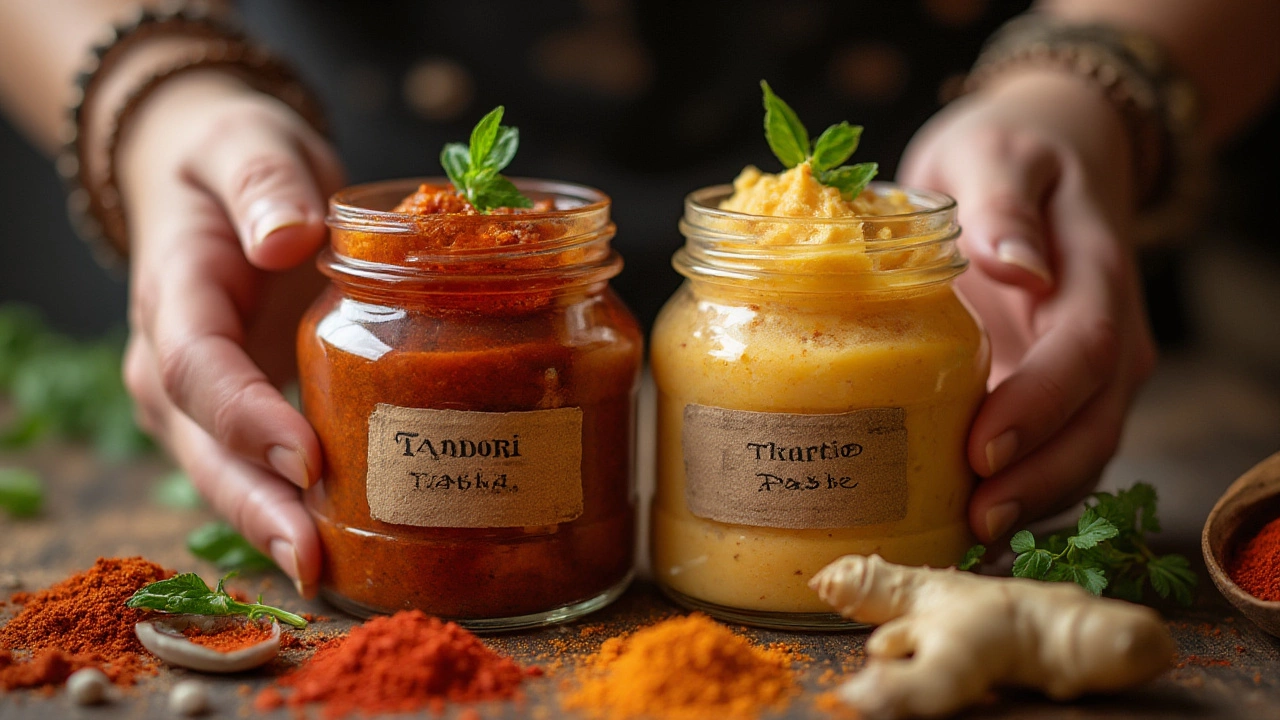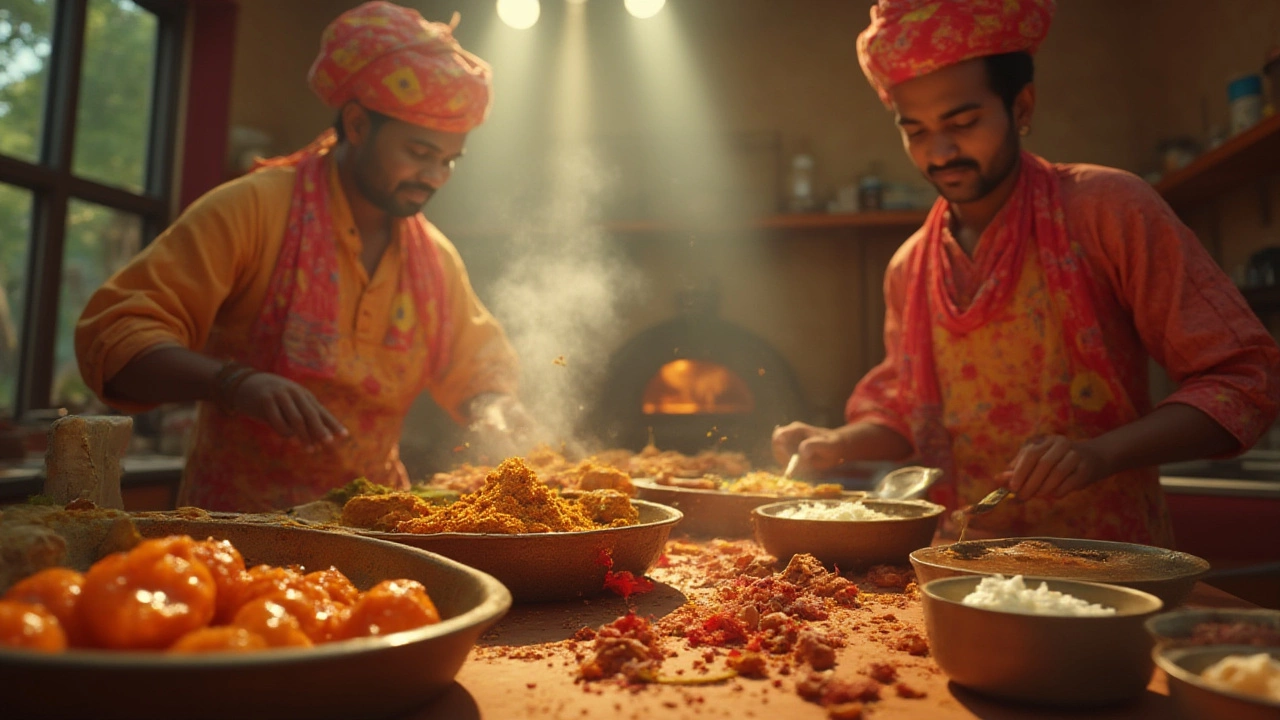No one really warns you about the emotional rollercoaster of hunting for the perfect tikka or tandoori paste at your local supermarket. The jars stare back: one labeled 'tandoori', one marked 'tikka'. Same deep earthy reds, a similar rush of toasted masala aroma when you open the lid. But here’s the plot twist: toss either on your chicken and magic happens—but not quite the same magic.
The Basics: What Are Tandoori Paste and Tikka Paste?
Let’s clear the confusion first. Both tandoori paste and tikka paste are used to marinate meat, seafood, paneer, and veggies, loading them up with those bold Indian spices. These pastes are not exactly interchangeable, even if they share a lot of the same base ingredients. Tandoori paste gets its name from the tandoor, a traditional clay oven used throughout India. Historically, tandoori paste is meant to handle intense heat and impart that classic smokiness you get from an actual tandoor. Tikka paste is designed for tikka dishes—small pieces of protein skewered and grilled. The word "tikka" actually means "bits" or "pieces." So while both make chicken taste better than it has any right to, they tell slightly different stories on your taste buds.
If you line up both pastes, ingredient-wise, you’ll notice a lot of overlap: yogurt, ginger, garlic, garam masala, coriander, cumin, chili, turmeric, and that deep scarlet color (sometimes boosted by food coloring or annatto seeds). But tikka paste often leans slightly creamier and less spicy—it’s made to cling to smaller bites so you get a gentler, more rounded flavor in each mouthful. Tandoori paste, though, likes to punch you with heat, tang, and a smoky edge. And in the best stuff, you’ll get notes of black salt or even a touch of mustard oil. That’s the secret to those smoky undertones you taste in real tandoori chicken at a restaurant.
Next time you’re holding a jar, flip it and skim the label. Do you see spicy red chili powder, mustard oil, or that extra dash of smoked paprika? You’re probably looking at tandoori. Spot extra cream, more yogurt, or even a hit of tomato? Likely tikka paste. That said, recipes and brands do their own thing—so don’t be shocked if you find some creative riffs.
Key Ingredients Breakdown: Spices, Yogurt, and the Flavor Factor
Some think all curry pastes are indistinguishable beyond the color, but that’s just blasphemy to any Indian grandma. Here’s where the DNA of tandoori vs tikka really splits. Both use yogurt as a base; it helps tenderize whatever you’re cooking and makes the flavors hold on tight. But with tandoori paste, brands often use less yogurt and more dry spices, leaning into heat and tang. You’ll get a mix of garam masala, cumin, ground coriander, a good whack of chili powder, and deep earthiness from smoked paprika.
Tikka paste backs off the chili and hits you with creamier, subtler flavors. You’ll usually find a higher proportion of yogurt or even fresh cream, with ground cumin and coriander still playing supporting roles. Some recipes toss in a spoonful of tomato paste or even lemon juice for a gentle acidity that dances with the creamy base. This blend means tikka dishes shine for people who want big flavor but a slightly gentler fire.
Spices aren’t the whole story. Oils make a big difference too. Mustard oil is common in tandoori blends, giving a sharp, peppery edge—it’s one of those flavors your nose registers even before your tongue wakes up. Conversely, tikka paste goes softer with neutral oils or ghee, ditching the extra smoke in favor of a lush creamy finish.
If you ever get your hands on both, try this: dab a little tandoori paste on your tongue. You’ll feel that instant hit of spice, followed by acidic tang, and a dusty trail of smoke. Now taste tikka paste. The burn doesn’t slam quite as hard. Instead, the yogurt softens the blow and carries a sweeter, rounder finish thanks to the tomatoes or extra cream.
| Ingredient | Tandoori Paste | Tikka Paste |
|---|---|---|
| Yogurt | Moderate | Higher |
| Cream | Rarely | Often |
| Mustard Oil | Typically | No |
| Chili Powder | More | Less |
| Smoked Paprika | Often | Sometimes |
| Tomato | No | Sometimes |
| Lemon Juice | Common | Sometimes |
India’s Ministry of Food Processing Industries reported that yogurt-based marinades, including tandoori paste, account for about 23% of all packaged Indian sauces sold for home use. That tells you how integral these pastes are for weeknight cooking across India—and how varied recipes can be.

How to Use Each Paste for Maximum Flavor
Here’s where things get exciting. You grabbed a jar of tandoori paste, but someone’s craving tikka masala in your kitchen. Time to improvise. If you only have tandoori paste, you can mimic tikka paste by stirring in extra yogurt or cream. This helps tame the heat, smooth out the texture, and gives you that creamy oomph classic in chicken tikka. Want actual tandoori notes, but only have tikka blend? Add a pinch of smoked paprika, an extra squeeze of lemon, and—if you’re brave—a drop of mustard oil. You’ll inch closer to *that* authentic tandoori flavor.
Tandoori paste works wonders as a marinade for large cuts: think chicken leg quarters, whole fish, or paneer steaks. Because it’s bold and tangy, it needs roasting or grilling to mellow out the raw edges. Baste with ghee while cooking for an ever deeper flavor. On the other hand, tikka paste shines with bite-sized pieces—chicken tikka, paneer tikka, or veggie skewers—ideally cooked fast over high heat until lightly charred. Try slathering it on cauliflower florets with a drizzle of oil before roasting for seriously addictive veggie bites.
If you’re after kitchen hacks, try this: for a saucy curry, use tikka paste as the base for your sauce. Fry it with onions, add tomatoes, finish with cream. If grilling? Reach for tandoori every time. Honestly, neither paste is only for meat. I use tandoori paste in scrambled eggs for a breakfast with a kick, or smear tikka paste inside a toasted sandwich with sliced paneer and greens. The possibilities are endless when you have both on hand.
- Tandoori paste is perfect for hearty, grilled dishes needing big, smoky flavors.
- Tikka paste suits milder, creamier, skewered recipes like paneer or classic chicken tikka.
- Add yogurt to tandoori paste as a tikka workaround if you’re in a pinch.
- Layer tikka paste under cheese on naan before baking for effortless flavor bombs.
- Try mixing a little tandoori paste into mayo or yogurt for a dipping sauce that’ll jazz up fries or roasted veggies.
Tips for Making Homemade Tandoori and Tikka Paste
It’s wild how much fresher homemade pastes taste—they’re brighter, punchier, and you control every ingredient (especially the spicy stuff). If you’ve only ever eaten jarred versions, give homemade a shot at least once. For tandoori paste, all you need is plain yogurt, heaps of ginger and garlic, ground coriander, cumin, Kashmiri chili powder (for color with mild heat), smoked paprika, a good pinch of salt, lemon juice, and a spoon of mustard oil for authenticity. Blitz it up until smooth and thick enough to stick to your spoon.
Tikka paste is even more of a crowd-pleaser when made fresh. Blend yogurt, a splash of cream, garlic, ginger, a little turmeric, cumin, coriander, a gentle pinch of chili powder, tomato paste (for a touch of tang and color), and salt. Squeeze in fresh lemon for some zing. Don’t be shy to taste as you go—Indian food loves boldness, and your spice level should make your mouth happy, not just follow someone else’s recipe.
The secret? Use freshly ground spices, not pre-ground dusty jars. Toast your seeds in a dry pan for 30 seconds first, then grind. This unlocks way more flavor. And don’t forget: fresh lemon juice—not bottled, please!—makes all the difference to cut through richness.
- Double up your batch and freeze the paste in an ice cube tray—pull out a cube and marinate in minutes.
- Add chopped fresh coriander or mint at the end for a fresh herby finish (tikka loves this especially).
- If you prefer deeper red color, stick with Kashmiri chili powder for mild heat and vibrancy instead of artificial dyes.
- For vegan versions, swap yogurt out for coconut yogurt and skip the cream.
- Home blends keeps flavor sharp for up to a week in the fridge, so use it up generously.

Are They Interchangeable? When to Swap and When Not To
You could use tandoori and tikka paste interchangeably in a pinch, but you’ll notice a difference. It’s like replacing cheddar with brie on a burger; both are cheese, but they change the vibe completely. For traditional dishes, stick with the classic: tandoori paste for tandoori chicken, tikka paste for tikka masala. If you blend them—say, marinate chicken with tandoori, then finish in a creamy tikka sauce—you might discover a new family favorite.
If you really want the best of both worlds (and who doesn’t?), try mixing equal parts of tandoori and tikka paste for your next roast veg tray or tofu bake. This gives you both a hit of spice and the creamy undertones people adore. And don’t feel boxed in by labels—generations of home cooks have riffed recipes to suit their own palates. It’s totally fair game to start your marinade with tandoori, then swap in tikka halfway if things get too fiery.
For allergy concerns, keep an eye out for mustard oil in tandoori blends, and dairy in tikka—you can easily work around both with vegan or nut-free yogurts. Also fun fact: studies in the UK (where Indian takeaway is almost its own food group) show chicken tikka masala was voted the country’s favorite dish 3 years running. That creamy orange sauce? Most takeaways shortcut with a good dollop of tikka paste as a base, then finish with cream and tomatoes. Tandoori, on the other hand, is king of the mixed grill platter.
The bottom line: tandoori and tikka pastes aren’t identical twins, but they’re definitely close cousins in the Indian kitchen. Use their differences to your flavor advantage, and you’ll never get bored of classic Indian marinades again.
